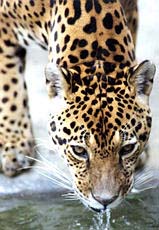
There is also the forested area of the National Research Institute of Amazonia (INPA), a complex made up of the Botanical Gardens, rich in plant species from the Amazon region, and the Zoological Gardens, which contain various animal species of the region, including some on the verge of extinction.
Photo: The Brazilian cougar: an endangered species - Luiz Prado/AE.
Within the scenario of the changes being suffered by the environment, the impoverishment of biodiversity is perhaps the most significant because it is the only change that is completely irreversible. Any animal or plant species, regardless of how insignificant it may seem, plays an irreplaceable role in the ecosystem of which its forms part and is the product of thousands of years of evolution.
When the last representative of a particular type of plant or animal disappears, it will never exist again. Sadly, this is the case with many species. The UICN, a major international organization for nature conservation, estimates that world-wide one or two plant species become extinct each day whilst the figure for animals varies from 50 to 250 each day.
Photo: The mico-leão-dourado (a capuchin monkey) is one of the most endangered animals of the Brazilian fauna and remains in danger despite the effort of several national and international organizations towards the preservation of the species - Savaget Productions Images.
Main causes for the extinction
There are three main causes for the extinction of living beings. The best known cause, hunting, is considered as being responsible for the disappearance of almost a quarter of species. The destruction of habitats accounts for 36% of the loss. The least known cause, yet one which is of major importance, is the introduction of species that are responsible for 39% of the destruction.
Literature contains numerous examples of plants and animals that have been taken by man from one region to another, causing real ecological disasters. A recently published case shows how the sapo cururu, a creature familiar to Brazilian children, could cause environmental damage in Australia, where it was introduced in the middle of the century
Photo: The mico-leão-dourado, a capuchin monkey, one of the most endangered species in the Brazilian fauna Masao Goto Filho/AE.
Golden Lion Monkeys Continue to Be Threatened
The golden lion monkey (Leontopithecus rosalia), one of the most threatened animals of Brazilian fauna, is still endangered, despite enormous efforts by various Brazilian and international organizations to restore the species. Starting from the Atlantic Forest, in the state of Rio de Janeiro, a recent census carried out by the biologist Cecília Kierulff of the Federal University of Minas Gerais indicated the existence of only 559 monkeys of which just 290 were living in the Biological Reserve at Poços das Antas in the municipality of Silva Jardim (Rio de Janeiro).
The others were found in areas without any protection where deforestation and hunting are not controlled. In addition to this problem, the populations are very small and the isolation between them has resulted in considerable inbreeding which in some cases has reached 100%. Cecília Kierulff predicts that this fact, together with hunting and deforestation which have continued in the region, may lead to the non-viability of the species during the next hundred years.
João Paulo Capobianco, 19 May 2001
Additional information
Information used with permission from the Brazil`s Ministry of External Relations.
Presentation of the author
João Paulo Capobianco is a biologist, photographer and an environmentalist specializing in Environmental Studies at the University of Brasília. He was founder and first chairman of the Association for the Protection of Juréia, founder and director of the Atlantic Forest SOS Foundation, a member of the National Co-ordinating Committee and the Executive Committee of the Forum of Brazilian Non Government Organizations preparatory to the Rio '92 summit, a representative of environmentalist bodies in São Paulo on the State Board for the Environment and a member of the Inter-ministerial Working Party and the Federal Government Consultative Group on Biological Diversity.
He is currently executive secretary of the Socio-environmental Institute, a member of the National Co-ordination of the NGO Network for the Atlantic Forest, a member of the Board of Management of the Atlantic Forest SOS Foundation, a representative of the São Paulo state government on the Temporary Technical Chamber for Atlantic Forest Affairs on the National Environment Board and a member of the co-ordinating committee for the National Programme for Biological Diversity.
